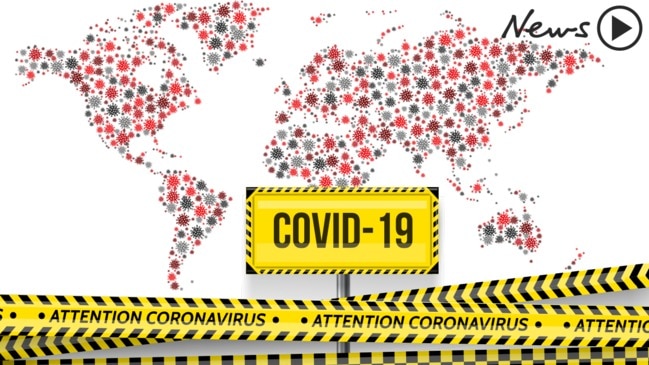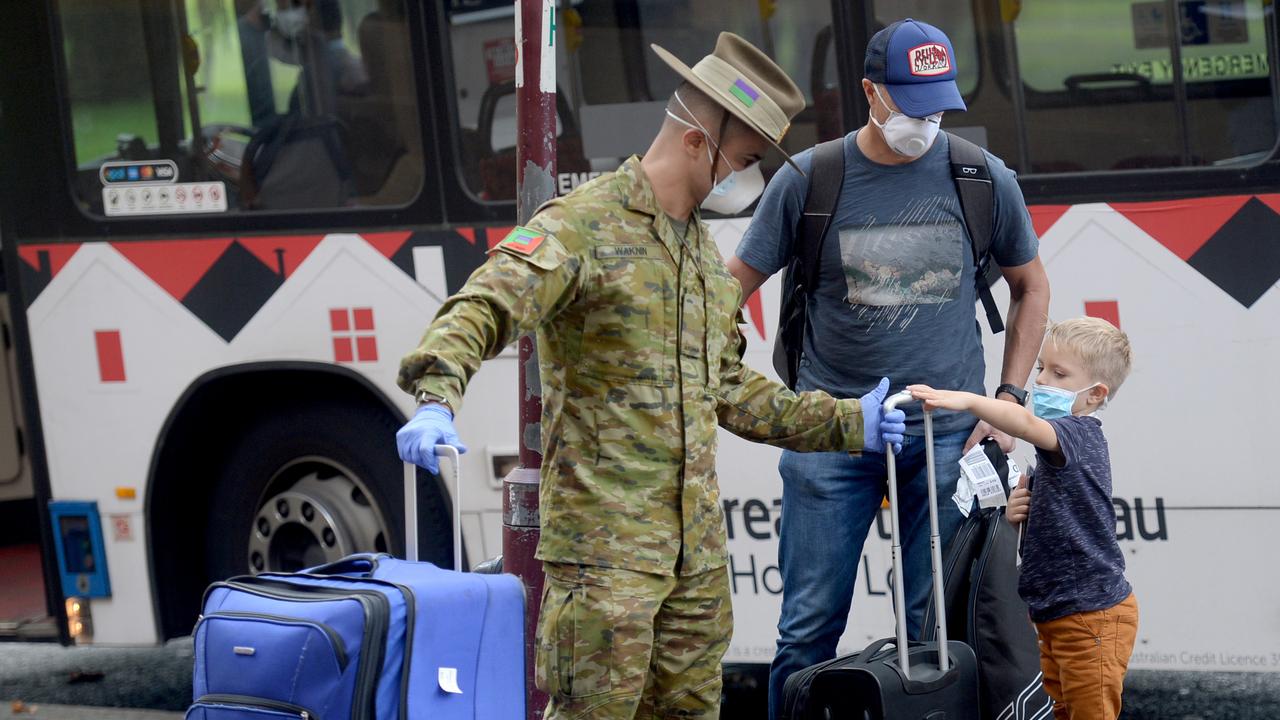Coronavirus Australia: COVID-19 cases in NSW, Victoria, Queensland, SA, WA, Tasmania, ACT and NT
A man in his 50s has become Australia’s youngest coronavirus victim so far as the death toll rises to 39 and confirmed cases approach 6000.

A man in his 50s has become Australia’s youngest coronavirus victim so far.
The death toll has risen to 39 after NSW and Victoria today each announced two more deaths.
“Yesterday a man in his 50s died in hospital and a woman in her 80s died at home," Victorian Health Minister Jenny Mikakos said on Twitter. "My thoughts are with their families."
A 61-year-old man who died at Hornsby Hospital in NSW over the weekend was previously the youngest.
It comes as the total number of confirmed COVID-19 cases in Australia approaches 6000, but chief medical officer Brendan Murphy says a slowing in the rate of new infections shows the country is in a “good place”.
Sunday saw "probably the lowest rise we've had for a few days" with 139 new cases "and it does tend to continue the trend we've seen of flattening of the curve", Prof Murphy told reporters yesterday.
"We're in a good place at the moment, we're achieving good control because the community has done what we have asked," he said.
There are now 5773 total cases, with 2637 in NSW, 1158 in Victoria, 907 in Queensland, 409 in South Australia, 453 in Western Australia, 86 in Tasmania, 96 in the Australian Capital Territory and 27 in the Northern Territory .
It came after five other deaths were announced on Sunday, four of them from the Ruby Princess cruise ship. A criminal probe into the disaster is now underway.

DEATH TOLL
Thirty-nine people have now died – three in WA, four in Queensland, 18 in NSW, 10 in Victoria, two in Tasmania and two in the ACT.
Australia’s first coronavirus fatality was on Sunday, March 1.
James Kwan, a 78-year-old Perth man, was among 163 Australians evacuated from the Diamond Princess cruise ship in Japan and quarantined at Howard Springs in the Northern Territory.
The second death came on Tuesday, March 3. The 95-year-old woman was a resident at the Dorothy Henderson Lodge in Macquarie Park, in Sydney’s north.
Two other residents of the same nursing home later died — an 82-year-old man on Sunday, March 8, followed by a 90-year-old woman on Saturday, March 14.
On Friday, March 13, a 77-year-old woman died in a Sydney hospital after recently arriving from Queensland. She had developed symptoms on the plane, was taken to hospital and died the same day.
An 86-year-old man died in a Sydney hospital on Tuesday, March 17, making him the state’s fifth death and the country’s sixth.
On Thursday, March 19, an 81-year-old woman died in hospital, bringing the death toll to seven. NSW Health said she had close contact with another confirmed case at Ryde Hospital.
The eighth death was a 77-year-old woman who was rushed to hospital after disembarking the Ruby Princess cruise ship in Sydney on March 14. She died in hospital on Tuesday morning, March 24.
The ninth death was another cruise passenger. Queensland man Garry Kirstenfeldt, 68, died in the afternoon on Wednesday, March 25, in intensive care at Toowoomba Hospital after returning from Sydney where he disembarked the Voyager of the Seas.
Two men in their 70s died in hospital in Victoria that same night, marking the state’s first deaths and the country’s 10th and 11th. On Thursday, March 26, another Victorian man in his 70s died in hospital. All three had pre-existing conditions.
Later that day, another man died in Joondalup Hospital in Perth after fainting in his home. Ray Daniels, 73, had disembarked the Celebrity Solstice cruise ship in Sydney six days earlier.
On Saturday, March 28, another Dorothy Henderson Lodge resident died in hospital, bringing the national death toll to 14.
The 15th and 16th deaths were announced moments apart on Sunday, March 28 – a 75-year-old female Ruby Princess passenger who died in Caboolture hospital, north of Brisbane, the previous night, and a man in his 80s who died at a Melbourne hospital.
On Monday, March 30, a woman in her 80s died at North-West Regional Hospital, making her Tasmania’s first death and the country’s 17th. She had been on board the Ruby Princess.
The national capital’s first death came over the weekend, but was announced by ACT Health announced on Monday afternoon, March 30. The woman in her 80s died at Canberra Hospital after acquiring the disease overseas.
Tasmania reported its second death and the nation’s 19th on Tuesday, March 31. The man in his 80s died at Royal Hobart Hospital. He had also been on board the Ruby Princess.
The 20th death came on Tuesday, March 31. The 95-year-old woman was the ninth NSW death and the fifth Dorothy Henderson Lodge resident to die.
On Wednesday, April 1, a NSW grandmother died at Orange Base Hospital in NSW’s Central West. She was the sixth Ruby Princess passenger to die and the first NSW death outside of Sydney.
Victorian officials announced on Thursday, April 2, that a woman in her 70s had died in hospital, making her the state’s fifth death and the country’s 22nd.
Later that morning, Queensland announced that an 85-year-old man had died overnight at Darling Downs Health Service Hospital in Toowoomba.
On Saturday, Victoria announced it had suffered one more death, with a woman in her seventies dying in hospital.
ACT Health then announced a man in his 80s had died at Canberra Hospital, the Territory’s second fatality. Federal Labor politician Ged Kearney revealed her 82-year-old father-in-law, Mike, was the 30th person to die of coronavirus in Australia.
On Sunday, April 5, NSW recorded four more COVID-19 deaths, including three former passengers of the coronavirus-stricken Ruby Princess cruise ship. The four victims were all men, bringing the state's COVID-19 toll to 16.
Of the three passengers who travelled on the Ruby Princess, a 91-year-old died at Port Macquarie Base Hospital. The other two men were aged 76 and 80 and died at Westmead Hospital.
The fourth man, aged 61, died at Hornsby Hospital. No details have been given about how he contracted the virus.
Later that day, Queensland announced that a 78-year-old man who had been on the Ruby Princess had died at The Prince Charles Hospital, marking the country’s 35th death.
NSW announced two more deaths on Monday, April 6. The two men, aged 85 and 86, both died at Liverpool Hospital on Sunday. The 86-year-old was a resident of the Opal Care Bankstown aged care facility. The 85-year-old was a close contact of another confirmed case.
Victoria also announced two more deaths, including the country’s youngest victim so far. Health Minister Jenny Mikakos said a man in his 50s had died in hospital and a woman in her 80s died at home on Sunday.

CORONAVIRUS AUSTRALIA
The majority of Australia’s coronavirus cases were acquired overseas.
Europe, the Americas and cruise ship travel are now the most common sources of infection, surpassing China.
People in their 20s make up the biggest proportion of confirmed COVID-19 cases due to the high number of returning travellers, with significantly more women than men testing positive in that age group.
Those in their 60s make up the second-largest group, followed by those in their 50s, 30s and 40s. Among those in their 40s, significantly more men than women have tested positive.
People in their 70s make up a smaller but still concerning number of total cases, while far fewer people aged over 80 or under 20 have been diagnosed.
The first case of COVID-19 was detected on January 25 in Victoria.
The patient was a man from Wuhan, Hubei province — where the Chinese virus emerged late last year — who flew to Melbourne from Guangdong on January 19.
Three more cases were detected the same day in NSW.
All three were men who had recently returned from China — two had been in Wuhan and one had direct contact with a confirmed case from the virus epicentre.
Since then, the number of cases has risen exponentially.
NSW quickly became ground zero for the Australian outbreak, and now makes up nearly half of all cases in the country.




